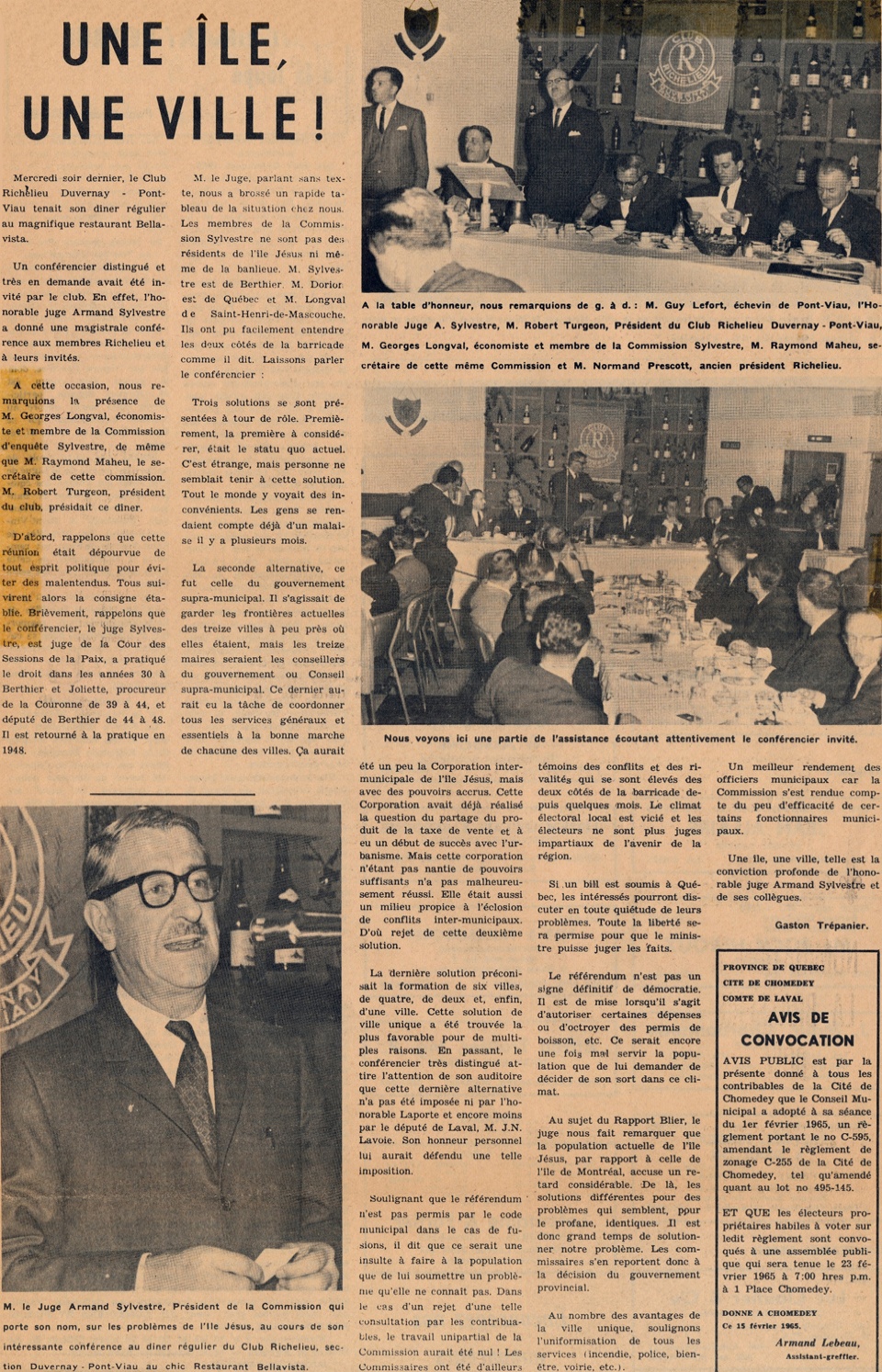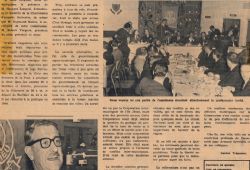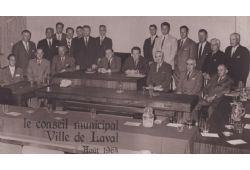Laval
celebrated its 50th anniversary in 2015. To commemorate the event,
more than 500 historical documents were published on the city’s official
website. Being the third largest city in the province after Montreal and Quebec
City, Laval’s creation story is worth learning about.
Laval History
& Heritage,
a new series brought to you by Laval
Families Magazine, is sure to offer its readers fascinating facts and
stories of our city’s past to its present.
Before 1854
Before
becoming a seigneury, Île Jésus was known to the First Nations peoples as a
resting place. During long voyages, the island was used as a place to recoup.
Quebec’s territory, then called New France, was colonized by the French. In
1636, Île Jésus was given to the Jesuits as a seigneury, hence its name.
At
that time, the seigneury wasn’t well exploited, and over time it passed through
the hands of several individuals and institutions. It belonged to François
Berthelot, counsellor and secretary to King Louis XIV. Three years later, in
1675, Berthelot passed it over to François Montmorency de Laval, a bishop, in
exchange for a small island on the St-Lawrence River called Île d’Orléans near
Quebec City. Under Montmorency de Laval, Île Jésus grew in population. In 1680,
the island was ruled by the Quebec Seminary until 1854. By 1702, the
Saint-François de Sales, Sainte-Rose de Lima, Saint-Martin and the
Saint-Vincent de Paul parishes began to take shape. In 1823, Île Jésus had a
population of 6500 on its primarily rural territory.
Municipal Reign
With
the abolition of the seigneurial system in 1854, the first municipal system was
created here permanently in 1855, also called the town system. This new system
of land management called for each group of 300 inhabitants to become a
municipality. At that time, populations were grouped by parish. In 1855, the
municipalities of Saint-François de Sales, Saint-Martin, Sainte-Rose de Lima
and Saint-Vincent de Paul were created. That same year, the Corporation du comté de Laval was
created, a form of government that permitted the mayors of the municipalities
to discuss issues of common interest.
By
1953, Île Jésus had 17 municipalities on its territory before finally coming
together to form a total of 14 with the creation of the City of Laval in 1965.
Becoming the City
of Laval
By
1950, much had changed in the perception of Île Jésus. Suburban neighbourhoods
were popping up, thanks to the increased popularity of the automobile.
Residents could commute to Montreal for work while living on Île Jésus. With
Île Jésus’s proximity to developed roads, bridges and highways, the shift from
an agricultural community to a residential one took place.
The
various sectors became their own towns, governed independently, even though
they shared the same territory. Some towns had more resources than others, and
some had more services than others. To alleviate this situation and to allow
the towns to progress and share municipal services, the Corporation du comté de Laval became the Corporation interurbaine de l’île Jésus in 1959. It was believed
that the island would benefit by becoming one city, and despite some
opposition, the Quebec Government announced the fusion of the towns.
On
August 6th, 1965, the City of Laval was officially inaugurated,
bringing together Auteuil, Chomedey, Duvernay, Laval-sur-le-Lac, Saint-François
and Sainte-Rose. Jean-Noël Lavoie became the first mayor of Laval on August 16th,
1965.
To
find out more or to access the historical documents, visit Laval’s website at
laval.ca/histoire-et-patrimoine.

 In The Latest Issue:Latest Issue:
In The Latest Issue:Latest Issue:
- A Bittersweet Farewell
- The new Laval Aquatic Co...
- The End of an Era:
Articles
Calendar
Virtual- ANNUAL TEACHER APPRECIATION CONTEST
- APPUI LAVAL
- ARTS & CULTURE
- CAMPS
- CAR GUIDE
- CCIL
- CENTENNIAL ACADEMY
- CHARITY FUNDRAISING
- CITYTV
- COSMODÔME
- COMMUNITY CONNECTIONS
- COVER STORY
- DINA DIMITRATOS
- ÉCOLE SUPÉRIEURE DE BALLET DU QUÉBEC
- EDITORIALS
- ÉDUCALOI
- EDUCATION
- EMPLOYMENT & ENTREPRENEURSHIP
- FÊTE DE LA FAMILLE
- FÊTE DU QUARTIER SAINT-BRUNO
- FAMILIES
- FESTIVAL LAVAL LAUGHS
- FÊTE DE QUARTIER VAL-DES-BRISES
- FINANCES
- GLI CUMBARE
- GROUPE RENO-EXPERT
- HEALTH & WELL-BEING
- 30 MINUTE HIT
- ANXIETY
- CHILDREN`S HEALTH & WELLNESS
- CLOSE AID
- DENTAL WELLNESS
- EXTREME EVOLUTION SPORTS CENTRE
- FONDATION CITÉ DE LA SANTÉ
- GENERAL
- HEARING HEALTH
- MESSAGES FROM THE HEALTH AGENCY OF CANADA
- MENTAL HEALTH
- SEXUALITY
- SOCIAL INTEGRATION
- SPECIAL NEEDS
- TEENS
- THE NUTRITION CORNER
- THE NUTRITION CORNER - RECIPES
- VACATION DESTINATION
- WOMEN'S FITNESS
- WOMEN'S HEALTH
- HILTON MONTREAL/LAVAL
- HOME & GARDEN
- INTERNATIONAL WOMEN'S DAY
- JAGUAR LAVAL
- LAVAL À VÉLO
- LAVAL FAMILIES TV SHOW
- LAVAL FAMILIES MAGAZINE CARES
- LAVAL URBAN IN NATURE
- LE PARCOURS DES HÉROS
- LES PETITS GOURMETS DANS MA COUR
- LEON'S FURNITURE
- LEONARDO DA VINCI CENTRE
- LFM PREMIERES
- LIFE BALANCE
- M.P. PROFILE
- MISS EDGAR'S AND MISS CRAMP'S SCHOOL
- MISSING CHILDREN'S NETWORK
- NETFOLIE
- NORTH STAR ACADEMY LAVAL
- OUTFRONT MEDIA
- PASSION SOCCER
- PARC DE LA RIVIÈRE-DES-MILLE-ÎLES
- PÂTISSERIE ST-MARTIN
- PIZZERIA LÌOLÀ
- PLACE BELL
- PORTRAITS OF YOUR MNA'S
- ROCKET DE LAVAL
- SACRED HEART SCHOOL
- SCOTIA BANK
- SHERATON LAVAL HOTEL
- SOCIÉTÉ ALZHEIMER LAVAL
- STATION 55
- STL
- SUBARU DE LAVAL
- TECHNOLOGY
- TEDXLAVAL
- TODAY`S LAURENTIANS AND LANAUDIÈRE
- TODAY`S LAVAL
- WARNER MUSIC
- THIS ISSUE
- MOST RECENT
Magazine
From Île Jésus to the City of Laval
Articles ~e 105,7 Rythme FM 4 chemins Annual Teacher Appreciation Contest Appui Laval Arts & Culture Ballet Eddy Toussaint Camps THIS ISSUE MORE...
CONTESTS Enter our contests
CONTESTS Enter our contests
CALENDAR
Events & Activities
COMMUNITY Posts Events
PUBLICATIONS Our Magazine Family Resource Directory
LFM BUSINESS NETWORK Learn more
COUPONS Click to save!
COMMUNITY Posts Events
PUBLICATIONS Our Magazine Family Resource Directory
LFM BUSINESS NETWORK Learn more
COUPONS Click to save!
SUBSCRIPTIONS
Subscribe to the magazine
Un-Subscribe
E-NEWSLETTER Subscribe to our E-newsletter Un-Subscribe
WRITE FOR US Guidelines & Submissions
POLLS Vote today!
E-NEWSLETTER Subscribe to our E-newsletter Un-Subscribe
WRITE FOR US Guidelines & Submissions
POLLS Vote today!
ADVERTISERS
How to & Media guide
Pay your LFM invoice
SUGGESTIONS Reader's Survey Suggest a Listing
LFM About Us Our Mission Giving Back Contact Us
SUGGESTIONS Reader's Survey Suggest a Listing
LFM About Us Our Mission Giving Back Contact Us
 PICK-UP LOCATIONS
Get a copy of LFM!
PICK-UP LOCATIONS
Get a copy of LFM!
TERMS & CONDITIONS Privacy | Terms
ISSN (ONLINE) 2291-1677
ISSN (PRINT) 2291-1677
Website by ZENxDESIGN





Tweet
Share